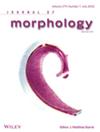Anatomy of the Critically-Endangered Anji Salamander (Hynobius amjiensis) Provides New Insights Into Morphological Evolution of Salamanders
Abstract
The Anji Salamander (Hynobius amjiensis) is a critically-endangered amphibian endemic to the Tianmushan Mountain area in southeastern China. As most of its congeneric species in the ancestral salamander family Hynobiidae, the osteology of H. amjiensis has remained essentially unknown and has hampered efforts in understanding morphological evolutionary patterns of early salamanders. Here, we investigate the skeletal anatomy of H. amjiensis based on microcomputed tomography scans of post-metamorphosed juvenile and adult specimens. Our results reveal Hynobiidae has more early-tetrapod-like plesiomorphic characters than expected, as H. amjiensis has a stapedial foramen in the middle ear and two centralia and a centrale-radius contact in the limb. We demonstrate that Hynobius amjiensis is the first known living salamander species with a stapedial foramen whose absence was believed to unite salamanders and anurans, and hence opens major questions on the evolution of the middle ear in modern amphibians: if some salamanders and caecilians had a stapedial foramen inherited from their common ancestor, when and how many times was the foramen lost independently in modern amphibians, and how did this structural loss impact the phylogenetic evolution of salamander clades? Our findings of hyper-ossified pectoral and pelvic girdles and loss of postminimus in the pes in H. amjiensis demonstrate that functional morphological features in hynobiids are potentially informative in phylogeny and ontogeny of early salamanders.


 求助内容:
求助内容: 应助结果提醒方式:
应助结果提醒方式:


